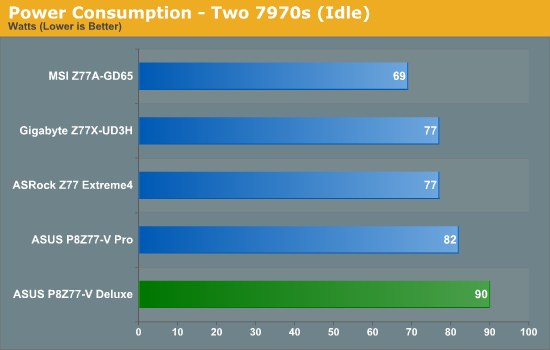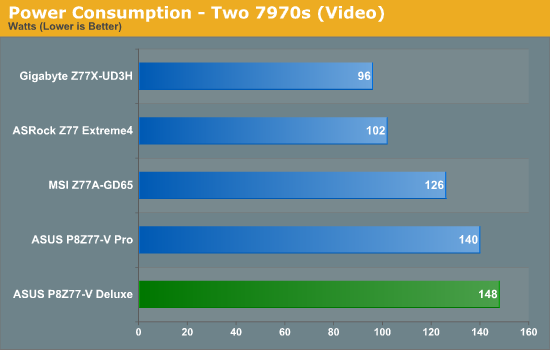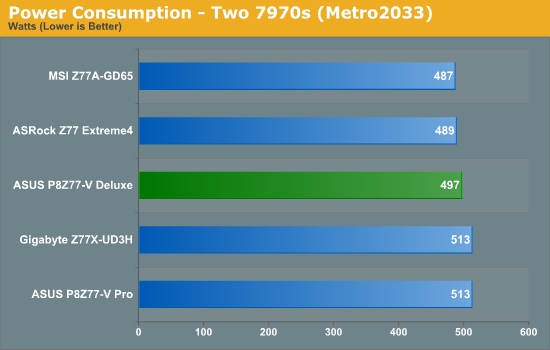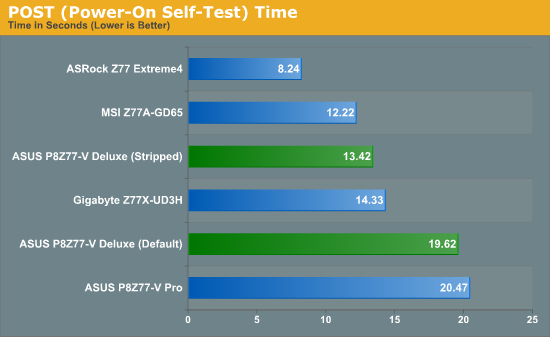ASUS P8Z77-V Deluxe Review - Know Your SKU
by Ian Cutress on May 12, 2012 8:45 AM EST- Posted in
- Motherboards
- Asus
- Z77
Test Setup
| Processor |
Intel Core i7-3770K ES 4 Cores, 8 Threads, 3.5 GHz (3.9 GHz Turbo) |
| Motherboards |
ASRock Z77 Extreme4 ASUS P8Z77-V Pro Gigabyte GA-Z77X-UD3H MSI Z77A-GD65 ASUS P8Z77-V Deluxe |
| Cooling | Intel All-in-One Liquid Cooler |
| Power Supply | OCZ 1250W Gold ZX Series |
| Memory |
GSkill RipjawsZ 4x4 GB DDR3-2400 10-12-12 Kit GSkill TridentX 2x4 GB DDR3-2666 11-13-13 Kit |
| Memory Settings | XMP (1866 9-10-9) |
| Video Cards |
ASUS HD7970 3GB ECS GTX 580 1536MB |
| Video Drivers |
Catalyst 12.3 NVIDIA Drivers 296.10 WHQL |
| Hard Drive | Micron RealSSD C300 256GB |
| Optical Drive | LG GH22NS50 |
| Case | Open Test Bed - CoolerMaster Lab V1.0 |
| Operating System | Windows 7 64-bit |
| SATA Testing | Micron RealSSD C300 256GB |
| USB 2/3 Testing | OCZ Vertex 3 240GB with SATA->USB Adaptor |
Power Consumption
Power consumption was tested on the system as a whole with a wall meter connected to the OCZ 1250W power supply, while in a dual 7970 GPU configuration. This power supply is Gold rated, and as I am in the UK on a 230-240 V supply, leads to ~75% efficiency > 50W, and 90%+ efficiency at 250W, which is suitable for both idle and multi-GPU loading. This method of power reading allows us to compare the power management of the UEFI and the board to supply components with power under load, and includes typical PSU losses due to efficiency. These are the real world values that consumers may expect from a typical system (minus the monitor) using this motherboard.




At lower loads, the power consumption on the Deluxe does seem a little high. This is due to ASUS' phase loading, in order to reduce the variation in voltages when lots of power is required instantly. This shows in the 2D benchmarks shown later in this review, which offer superior numbers.
POST Time
Different motherboards have different POST sequences before an operating system is initialized. A lot of this is dependent on the board itself, and POST boot time is determined by the controllers on board (and the sequence of how those extras are organized). As part of our testing, we are now going to look at the POST Boot Time - this is the time from pressing the ON button on the computer to when Windows starts loading. (We discount Windows loading as it is highly variable given Windows specific features.) These results are subject to human error, so please allow +/- 1 second in these results.

As requested, for future POST tests we will include an additional 'stripped' test, whereby controllers are turned off (USB 3.0, NIC, Audio, SATA Controller). The Deluxe is like the Pro, in that the onboard testing to make sure everything works takes an extra few seconds over other products.
Overclocks
Here at AnandTech we want to provide quick and easy ways to determine if a board is good for you (with in-depth analysis of course). So here is a quick round up of our overclocking results. Overclocks are tested for stability with PovRay and OCCT - while these may not be the most strenuous of stability tests, it does offer a quick check for memory errors under high load (and also balances testing time with getting the next board on for review!).
|
CPU Speed (MHz) |
Voltage (Volts) |
PovRay Peak Temp (ºC) |
OCCT Peak Temp (ºC) |
Notes | |
|
ASRock Z77 Extreme4 |
4700 | 1.175 | 86 | 86 | LLC Level 1 |
|
ASUS P8Z77-V Pro |
4700 | 1.200 | 83 | 86 | PLL Overvoltage enabled |
|
Gigabyte Z77X-UD3H |
4700 | 1.200 | 82 | 86 | LLC Extreme |
|
MSI Z77A-GD65 |
4700 | 1.250 | 90 | - | PLL Overvoltage enabled |
|
ASUS P8Z77-V Deluxe |
4700 | 1.225 | 89 | 84 | PLL Overvoltage enabled |










52 Comments
View All Comments
IanCutress - Monday, May 14, 2012 - link
We tested both, as there is two green lines in that graph. Whereas the Realtek seems to win out in pure throughput in our testing, the Intel other has more configurable advantages analogous to Intel NICs.Many thanks for the correction :)
Ian
BrunoLogan - Saturday, May 12, 2012 - link
I'm thinking about building a new machine with the standard version of this board. As we're going to have a new micro architecture next year, I consider pricier boards as throwing money out the door. It will only be useful for Ivy Bridge generation. Next upgrade and you'll have to trash it because Intel will surely change the socket.justaviking - Saturday, May 12, 2012 - link
Based largely on the Z77 motherboard roundup a few days ago (May 7) I ordered the ASUS P8Z77-V Pro to go with a i7-3770k processor. I have one legacy board (a video capture card) that is important to me, so I HAD to have a regular PCI slot. And when the price dropped $25, I said "woo hoo!" and ordered it.The performance against the Deluxe has really made me feel good today. I should have both the CPU and motherboard in a few days.
brickman - Saturday, May 12, 2012 - link
Same here. Quickly grabbed that V-Pro for $210. Although I'll be using an i7 2700KASUS seems to be really standing out with the motherboard features. Integrated wireless without a slot being taken is a big plus. Also WiFI go will be great for my ASUS transformer tablet.
gldg - Saturday, May 12, 2012 - link
I noticed that the memory sticks listed in the test setup are both quad channel. Is that a goofed link or can you put quad channel in the dual channel Z77 chipset?Also, could someone tell me what happens when you put 1.65V sticks in this board? I've seen alot of warnings around using 1.65V kits with Ivy...if I put (for example) 2800 1.65V RAM in, can I set it to 1600 and 1.5V in the BIOS?
KivBlue - Saturday, May 12, 2012 - link
I don't see how 1.65V RAM would be an issue, that's the highest Voltage recommended by Ivy Bridge CPU. It also officially supports up to 1600mhz, but Sandy Bridge only supported up to 1333mhz yet there were no issues with people using 1600mhz RAM with Sandy Bridge. If the mobo supports RAM overclock of 2800 I don't see a problem, but it's either going to not work with Ivy Bridge or won't make much of an actual performance boost.Azethoth - Monday, May 14, 2012 - link
It is not a goofed link. My ASUS P8Z77-V Deluxe has 4x8=32Gb (G.SKILL Trident X Series 16GB (2 x 8GB) 240-Pin DDR3 SDRAM DDR3 2400 (PC3 19200) Desktop Memory Model F3-2400C10D-16GTX).If you read the launch lineup, Asus actually did something special with memory. Instead of serial access they parallelized it which means their timings are tighter than the old scheme and they are getting stable overclocks to 2800. Also, you are not penalized for populating all 4 slots. Their 2800 G.Skill qualified memory was with 4x4 dimms: http://dlcdnet.asus.com/pub/ASUS/mb/LGA1155/P8Z77-...
The Trident X they did that with does not show up on any online store yet which is why I went with 2 sets of the DDR3 2400 kit from newegg.
IanCutress - Monday, May 14, 2012 - link
Hi gldg,There was an error in my test setup. For Ivy I am using F3-19200CL9Q-16GBZMD (4x4 GB kit) and F3-2666C11D-8GTXD (2x4 GB Kit) - first for 16 GB compatibility (that kit is notorious on certain boards) and the second for speed testing.
There should be no issues putting a quad channel kit in a dual channel board. The number of channels is determined by the CPU probing the memory at boot, not the memory telling the system how many channels to run in. Hence why you can run Quad channel kits in X79 with 1-3 sticks for single to tri-channel respectively. It's all mix and match now :)
All the best,
Ian
gldg - Monday, May 14, 2012 - link
Thanks Kiv, Aze and Ian. Re. the voltage, I had glanced at the QVL but I wasn't sure if it was a case of Asus telling me I *could* get those speeds and volts under the right circumstances, versus Intel telling me *should* stay below their official recommended max of 1.5V. It's been a few chipsets since I've built a full enthusiast rig and wasn't sure how everything would behave at default.The quad channel issue is good to know and opens up bunches of more options. Any reason why there's no 32GB kits listed on the QVL at any speed?
Thanks for a great review Ian.
Azethoth - Wednesday, May 16, 2012 - link
Now that you mention it they did not qualify any 8GB dimms.Well, anecdotaly, the kit I linked is running at its rated 2400 clock speed. There is something weird with the bios not automatically running it at high speed but there is a single bios setting to crank it up with.
Maybe it is just a pure cost thing. Not testing 8GB kit saves money and 32GB ran me over $400. On the other hand, if your kit makes the grade it is pure free advertising so memory vendors probably provide them for free. G.Skill will probably clean up this cycle since they got the high score.